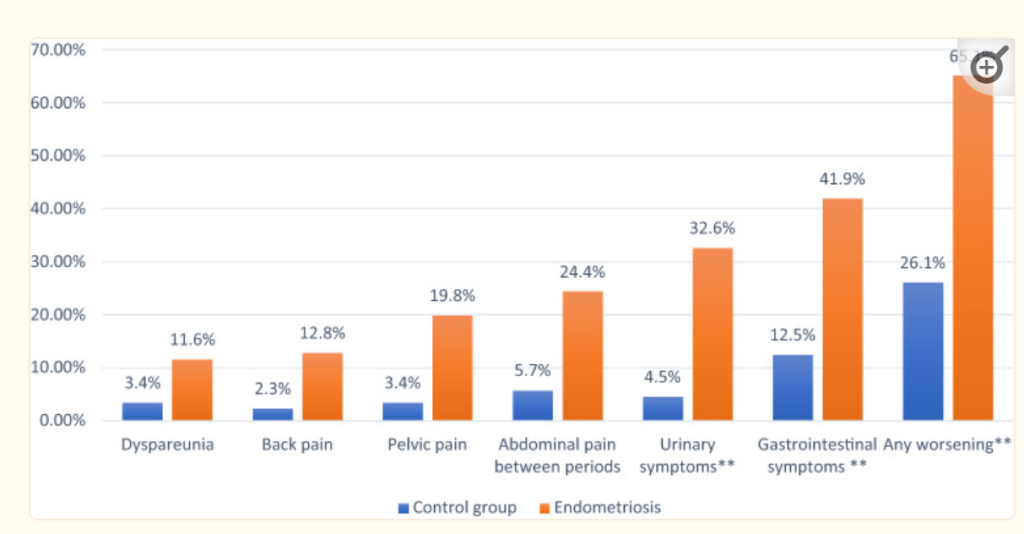The coordinator of a UK Long COVID group asked me to research and post on this topic. Endometriosis is one form of infertility that has a prevalence around 7%. When I checked the US National Library of Medicine for Endometriosis and microbiome, I found 88 studies most published in 2021 and later. It is a newly discovered association. I have added it to my PubMed Study page with bacteria listed here and a priori changes of diet to counter these shifts listed here.
I repeated searching the US National Library of Medicine for Endometriosis and microbiome for endometriosis and COVID. I found 66 studies — a volume that surprised me! A few studies that appear interesting:
- Patients with endometriosis may experience worse clinical manifestations and therapeutic outcomes during COVID–19 in western China- a case series comparative analysis. [2023] . We know from other studies that the microbiome determines the severity of COVID; thus having an altered microbiome (from endometriosis) is likely to be a contributor.
- Association of laparoscopically-confirmed endometriosis with long COVID–19: a prospective cohort study. [2023]. We know that long COVID has an altered microbiome and it would not be unexpected that some alterations would predispose some people to endometriosis by the microbiome alterations.
- COVID–19 susceptibility in endometriosis patients: A case control study. [2022] “women with endometriosis had a higher frequency of COVID-19 than the control subjects (23% vs. 13.5%), with a greater prevalence of fever (14.4% vs. 6%) and myalgias or arthralgias (11.4% vs. 4.5%)”
- A review on human reproductive systems encountering with the severe acute respiratory syndrome coronavirus 2 infection. [2023] which reports “female reproductive failures (polycystic ovary syndrome and endometriosis) increases the susceptibility to COVID-19.”
- The effect of SARS–CoV–2 BNT162b2 vaccine on the symptoms of women with endometriosis. [20223] reports “worsening in dysmenorrhea in the endometriosis patient group (39% vs 15%)

Concurrence between Microbiome Shifts
From the database I compared shifts between COVID and endometriosis, with the shift in common shown below.
| Tax Name | Tax Rank | Shift |
| Coriobacteriaceae | family | High |
| Enterobacteriaceae | family | High |
| Atopobium | genus | High |
| Bacteroides | genus | High |
| Bifidobacterium | genus | High |
| Blautia | genus | High |
| Campylobacter | genus | High |
| Candida | genus | High |
| Corynebacterium | genus | High |
| Dialister | genus | Low |
| Escherichia | genus | High |
| Faecalibacterium | genus | High |
| Lachnospira | genus | Low |
| Lactobacillus | genus | Low |
| Odoribacter | genus | Low |
| Parabacteroides | genus | High |
| Paraprevotella | genus | Low |
| Prevotella | genus | High |
| Pseudomonas | genus | High |
| Ruminococcus | genus | Low |
| Shigella | genus | High |
| Streptococcus | genus | High |
| Eubacteriales | order | Low |
| Actinobacteria | phylum | High |
| Firmicutes | phylum | High |
| Proteobacteria | phylum | High |
| Verrucomicrobia | phylum | High |
Can COVID cause Endometriosis
There is no clear evidence of that, but the table of common shifts implies that it is a reasonable hypothesis. Looking at numbers from Long COVID groups, you may see over representation (above the 7% expected). Endometriosis increased the odds (almost double) of getting COVID then seeing 14% of Long COVID population with Endometriosis could be explain by the increase risk of getting COVID.
On the brighter side, we now see that endometriosis has a significant microbiome dimension and thus treatment by microbiome manipulation becomes an option worth exploring.
Recent Comments